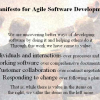Process
Articles
 |
The Value of Test-Driven Development when Writing Changeable Code Writing changeable code makes it easier and more cost-effective to add features to existing software. Writing changeable code doesn’t take longer, but it does require paying attention to certain things when building a system. It's important to have a good suite of unit tests that support refactoring code when needed, and test-driven development helps you create independently testable code. |
|
 |
DevSecOps: Incorporate Security into DevOps to Reduce Software Risk DevSecOps is a growing movement to incorporate security into DevOps practices in order to ensure flaws and weaknesses are exposed early on through monitoring, assessment, and analysis, so remediation can be implemented far earlier than traditional efforts. By failing fast with security testing, organizations reduce risk of a security incident and decrease the cost of rework. |
|
 |
Document Why as Well as What: Finding the Purpose of Your Software Code can express what we want to accomplish, but it’s a little more difficult to express why we’re doing something in the first place. The people who maintain code are often not those who originally wrote it, so documenting why helps set a context and gives clues as to what the author was thinking when they came up with a particular design, making developers' jobs easier. |
|
 |
Has Continuous Deployment Become a New Worst Practice? Software development has been moving toward progressively smaller and faster development cycles, and continuous integration and continuous deployment are compressing delivery times even further. But is this actually good for businesses or their users? Just because you can deploy to production quickly and frequently, should you? |
|
 |
IoT Security Should Start with the UI Setup IoT security is a large and changing topic, but there is one basic starting point where device security can be improved during development and testing: the user interface. The UI should be the first line of defense, but it’s currently weak in most IoT devices. Implementing better practices during the initial UI setup will go a long way toward improving security. |
|
 |
Testing during Transition: Test Criteria for Outsourced Software In the world of IT outsourcing, it is not uncommon for a company to have its applications and infrastructure developed or maintained by others. As vendors compete for this business, a common trial is testing the transition activity as a whole. How would you design acceptance criteria of a transition trial so that it is testable and clearly communicated? |
|
 |
Test Coverage in the Age of Continuous Delivery Test coverage is a strategy to help us spend scarce testing time on the right priorities. When things were tested last, how much automation coverage we have, how often the customers use the feature, and how critical the feature is to application are all factors to consider. Here are some ideas for keeping quality high when you're transitioning to continuous delivery. |
|
 |
Overcome Test Automation Plateaus with Service Virtualization With complex enterprise test automation systems, at least some of the many required dependencies are commonly incomplete, unavailable, or operating incorrectly at the time of test execution. The result is timeouts, incomplete tests, false positives, and inaccurate results. Service virtualization can help you overcome this plateau and increase test automation rates. |
|
 |
Tester-Driven Unit Testing: Taking an Active Role Developers have so much to do that unit tests often fall by the wayside. One solution is to train testers to handle them. Testers get involved earlier in the development lifecycle, they can enhance their programming skills, and bugs are found and fixed quickly and easily, reducing the functional testing phase. Consider taking an active role in unit testing. |
|
 |
Let the Agile Manifesto Guide Your Software Testing Although its values are commonly associated with agile software development, the Agile Manifesto applies to all people and teams following the agile mindset, including testers. This article examines the four main values of the Agile Manifesto and reveals how they can bring agility to test efforts—improving quality for your team and your customers. |











